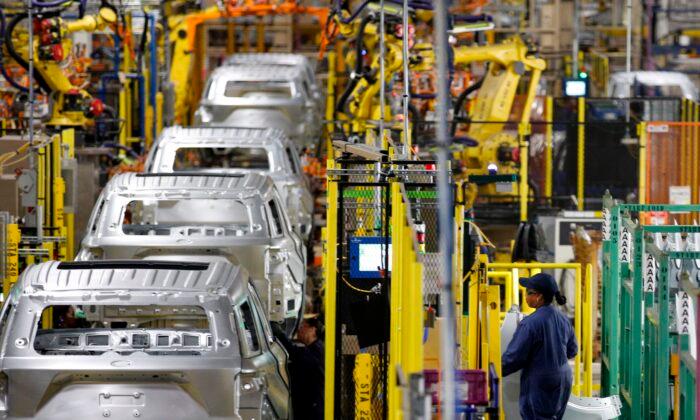In a fresh sign that recessionary winds are cooling the labor market, the number of job openings in the United States has dropped to a two-year low while America’s manufacturing sector extended its decline.
The Labor Department’s latest Job Openings and Labor Turnover Survey (JOLTS) shows that job openings fell to 9.58 million in June, the lowest level since April 2021.
The level of layoffs and discharges remained little changed over the month, while the number of hires declined by 326,000 to 5.9 million.
The biggest over-the-month drops in hiring activity were in retail trade (-93,000), health care and social assistance (-69,000), and durable goods manufacturing, which saw a net decline of 54,000 positions.
Some analysts saw evidence of economic resiliency the labor market data, which also showed 1.6 open jobs for every unemployed person. While that’s down from its peak near 2.0, it’s still than higher pre-pandemic levels, suggesting that the labor market remains relatively tight despite signs of softening.
“While today’s report discusses data from June, this continued strength in the labor market is likely to keep Fed officials hawkish,” Eugenio Aleman, chief economist at Raymond James in St. Petersburg, Florida, told Reuters.
With less than 50 days until the Federal Reserve’s next interest rate-setting meeting of the Federal Open Market Committee (FOMC), markets have been increasingly focused on where the central bank takes rates from here after an aggressive hiking cycle in the face of soaring inflation.
Investors are overwhelmingly betting (82.5 percent odds) that the Fed will hold rates steady in September at the current level of 525–550 basis points (bps).
Some analysts say that if inflation shows any signs of rising, the Fed is likely raise rates further in light of the relatively strong labor market data.
“The labor market is BOOMING. No problem with 525 bps of hikes. So, no reason to pivot. And if inflation perks up, the labor market can handle another round of hikes,” market analyst and macro researcher Jim Bianco posted on social media.
Others say it’s less clear where the Fed goes from here.
“The Federal Reserve raised interest rates again last week and kept future options open in its war against inflation,” Bankrate senior economic analyst Mark Hamrick told The Epoch Times in an emailed statement.
“Like a summer blockbuster, we’re wondering about the next possible plot twist in the Fed and inflation story.”
Still, the JOLTS data point to a softening trend in the labor market, with resignations plunging by the most since April 2020.
The number of quits decreased to 3.8 million (down by 295,000 from the prior month) while the quits rate ticked down to 2.4 percent. This suggests workers are growing less confident in the labor market.
Manufacturing ‘Malaise Persisting’
Two sets of factory data—one from the Institute of Supply Management (ISM) and the other from S&P Global—showed that the U.S. manufacturing slump remained mired in a recession zone.The more upbeat of the two reports—the S&P Global U.S. Manufacturing Purchasing Managers Index (PMI)—showed America’s manufacturing industry remained mired in recession in July, although hiring activity rose, in part on the back of an increase in business optimism about future conditions.
“Manufacturing continues to act as a drag on the U.S. economy, the recent spell of malaise persisting at the start of the third quarter,” Chris Williamson, chief business economist at S&P Global Market Intelligence, said in a statement.
The S&P Global data showed that the manufacturing sector continued to suffer from lower demand as evidenced by a drop in new orders, while a rise in manufacturing input costs for the first time in three months threatens to fan the flames of inflation.
One of the more notable bright spots in the S&P report was a marked improvement in the year-ahead business expectations for output.
‘Demand Remains Weak’
The less optimistic of the two sets of factory data—ISM’s Manufacturing Purchasing Managers Index (PMI)—showed that economic activity in the U.S. manufacturing sector contracted in July for the ninth consecutive month.The July reading, per ISM, was 46.1 percent, which is 0.4 percentage points higher than the 45.7 percent notched in June.
Readings below 50 represent contraction, or recession.
“The U.S. manufacturing sector shrank again, but the uptick in the PMI indicates a marginally slower rate of contraction,” Timothy Fiore, chair of the ISM manufacturing business survey committee, said in a statement.
Overall, of America’s six biggest manufacturing industries, only petroleum and coal products showed growth in July.
Softness persisted in the area of demand. The new orders index improved a little in June, but remained mired in recession, while a measure of new export orders fell deeper into contraction territory.
“Demand remains weak but marginally better compared to June, production slowed due to lack of work, and suppliers continue to have capacity,” Mr. Fiore said.
But the sharpest decline was in terms of manufacturing jobs, per the ISM data.
The ISM employment index fell by 3.7 percentage points in July, from 48.1 in the prior month to 44.4.
“There are signs of more employment reduction actions in the near term to better match production output,” Mr. Fiore commented.
ISM and S&P Global use different survey methodologies, and it’s not uncommon for the numbers to differ in certain areas, such as hiring activity.





